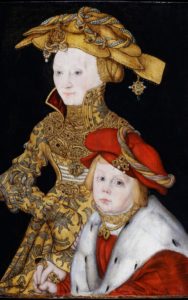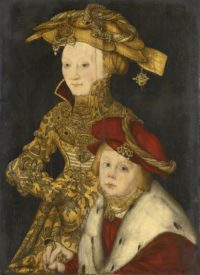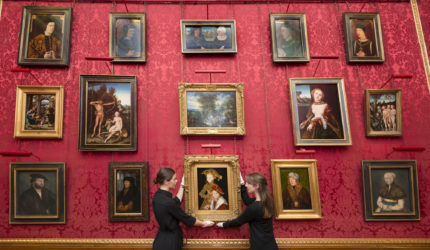 Pigeon tendons have confirmed that Queen Victoria was right and a slew of subsequent Royal Collection curators were wrong: a painting she acquired is an authentic work by Lucas Cranach the Elder. Victoria bought it in 1840 as a Christmas present for her husband Prince Albert who was an avid collector of his countryman’s work and ultimately added a dozen paintings by the master himself or his workshop to the Royal Collection.
Pigeon tendons have confirmed that Queen Victoria was right and a slew of subsequent Royal Collection curators were wrong: a painting she acquired is an authentic work by Lucas Cranach the Elder. Victoria bought it in 1840 as a Christmas present for her husband Prince Albert who was an avid collector of his countryman’s work and ultimately added a dozen paintings by the master himself or his workshop to the Royal Collection.
Portrait of a Lady and her Son (ca. 1510–40) is a double portrait of an Electress of the Holy Roman Empire and her apple-cheeked son wearing exquisite finery and holding hands. She and Albert did not question its attribution as a genuine Cranach, but by the early 20th century Royal Collection Trust experts reluctantly acknowledged that it was not by Cranach or even by his workshop. Instead, they believed it was painted by Franz Wolfgang Rohrich (1787–1834), who was an extremely successful Cranach forger. He cranked out more than 40 copies of the Electress holding her son’s hand and sold them to deep-pocketed collectors all over Europe. It took decades for people to cotton on to Rohrich’s fraudulent imitation game, and many of his pseudo-Cranachs are still in Europeans private and public collections.
 Royal Collection Trust’s reasoning was that the style, principally the tender physical and emotional connection between mother and son, was not something seen in Cranach’s oeuvre. His figures are remote and stylized. Holding Mommy’s hand is not in Lucas Cranach the Elder’s wheelhouse. Also, while the Rohrich versions were everywhere, there was no painting that could be definitively identified as a Cranach original modified by the forger.
Royal Collection Trust’s reasoning was that the style, principally the tender physical and emotional connection between mother and son, was not something seen in Cranach’s oeuvre. His figures are remote and stylized. Holding Mommy’s hand is not in Lucas Cranach the Elder’s wheelhouse. Also, while the Rohrich versions were everywhere, there was no painting that could be definitively identified as a Cranach original modified by the forger.
The issue returned to the fore recently when the Royal Collection Trust agreed to loan the portrait to an exhibition in Dusseldorf that took place earlier this year. RCT conservators and curators worked with Cologne’s University of Applied Sciences to study the painting in depth with technology that wasn’t invented when the early 20th century curators made the deattribution decision.
In collaboration with TH Köln (the University of Applied Sciences, Cologne), Royal Collection Trust’s conservators and curators examined the work ahead of its loan to the major exhibition Cranach der Alterer: Meister Marke Moderne at the Museum Kunstpalast, Düsseldorf in spring 2017. Infrared reflectography was used to look beneath the paint surface, revealing preliminary underdrawing typical of Cranach’s work. Analysis of the pigments, metal leaf and the application of paint provided further evidence that the portrait was a work of the 16th century.
Finally an x-ray of the painting revealed that a fibrous material had been used in the preparation of the panel. Analysis of similar fibres on other works by Cranach has identified them as tendons, and in one instance DNA analysis had shown them to be pigeon tendons. Sixteenth-century glue recipes often included pigeon tendons to strengthen the mixture and counteract the natural warping and splitting of the wood.
The evidence was reviewed by Professor Dr Gunnar Heydenreich of TH Köln, an expert on Lucas Cranach the Elder, who confirmed that the painting was an original work by the master from which it appears all later versions derive.
The Royal Collection Trust conservators are ecstatic at the reattribution of the portrait to Cranach and have wasted no time in giving it a prominent position on public display. It has been installed at eye-level in the King’s Dressing Room at Windsor Castle where it will keep company with its brethren by Cranach and his workshop, including Apollo and Diana (ca. 1526), Lucretia (1530), and The Judgement of Paris (ca. 1530–35).

Of course The Royal Collection Trust experts were thrilled at the re-attribution of the portrait to Cranach! Forgeries, especially great forgeries, shake up the market and destroy galleries/private buyers’ confidence.
But if this “Portrait of a Lady and her Son” was the original work by Cranach, what have the owners of all the subsequent versions been told?
They probably have not been told anything, it is up to them to figure it out. Many of the owners of the forgeries probably already know that they have a forgery.
Well, there’s Germany paid us 0.0000001% of the reparations she owes us.
In Upper Franconia, the districts of ‘Kronach’ (home and birthplace of Cranach) and ‘Coburg’ (Albert’s former home and birthplace) lay directly next to each other. Presumably, therefore, Albert might have been an avid Cranach collector (simply don’t know, just guessing).
The piece definitely looks like a Cranach, but more like one that he either painted ‘business minded’, or that he simply let his workshop do in the first place. Frankly, there are works by him that look much better, and executed with much more care.
Dierie, have your fun with this … “Thing” :p
Dear Dearieme,
Your comment come perilously close to political dialog, which, IMO, is inappropriate here.
Historically, in 2010 Germany paid off the last of its 1950s bonds which paid the remaining WW1 reparations to the Allies. The US was never assigned any formal dollar amount of reparations for WW2 but we got things like the V2s and Werner von Braun as well as rights to a lot of Nazi era intellectual property.
Pigeon tendons! Who’d a thunk it?
OK, Bertie was indeed an “avid collector” (cf. the text on here). I wonder, though, what the pigeon animal glue / tendon actually does prove:
As “the first known written procedures of making animal glue were written about 2000 BC. Between 1500–1000 BC, it was used for wood furnishings and mural paintings [, and seemingly this was by the 19th century not out of fashion]”.
Is there more to their “analysis of the pigments, metal leaf and the application of paint” than just the pigeons – Or was their analysis possibly more ‘avian’ than ‘avid’ ?
———————-
PS: Dearie, it seems that you e.g. still have that -obviously pirated- Merowingian pot ! :hattip:
Reparations for what? Dresden awaits your answer.